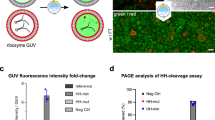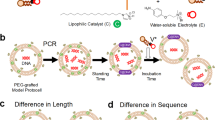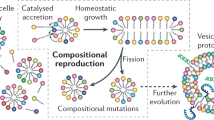Abstract
The advent of Darwinian evolution required the emergence of molecular mechanisms for the heritable variation of fitness. One model for such a system involves competing protocell populations, each consisting of a replicating genetic polymer within a replicating vesicle. In this model, each genetic polymer imparts a selective advantage to its protocell by, for example, coding for a catalyst that generates a useful metabolite. Here, we report a partial model of such nascent evolutionary traits in a system that consists of fatty-acid vesicles containing a dipeptide catalyst, which catalyses the formation of a second dipeptide. The newly formed dipeptide binds to vesicle membranes, which imparts enhanced affinity for fatty acids and thus promotes vesicle growth. The catalysed dipeptide synthesis proceeds with higher efficiency in vesicles than in free solution, which further enhances fitness. Our observations suggest that, in a replicating protocell with an RNA genome, ribozyme-catalysed peptide synthesis might have been sufficient to initiate Darwinian evolution.
This is a preview of subscription content, access via your institution
Access options
Subscribe to this journal
Receive 12 print issues and online access
$259.00 per year
only $21.58 per issue
Buy this article
- Purchase on Springer Link
- Instant access to full article PDF
Prices may be subject to local taxes which are calculated during checkout







Similar content being viewed by others
Change history
03 June 2013
In the version of this Article originally published, in Fig 3a, the description for the open triangle should have read: '1 equiv. dye-labelled empty vesicles + vesicles without dipeptide'. This has been corrected in the HTML and PDF versions of the Article.
References
Monnard, P. A. & Deamer, D. W. Membrane self-assembly processes: steps toward the first cellular life. Anat. Record 268, 196–207 (2002).
Szathmary, E. & Demeter, L. Group selection of early replicators and the origin of life. J. Theor. Biol. 128, 463–486 (1987).
Szostak, J. W., Bartel, D. P. & Luisi, P. L. Synthesizing life. Nature 409, 387–390 (2001).
Budin, I. & Szostak, J. W. Expanding roles for diverse physical phenomena during the origin of life. Ann. Rev. Biophys. 39, 245–263 (2010).
Gebicki, J. M. & Hicks, M. Ufasomes are stable particles surrounded by unsaturated fatty acid membranes. Nature 243, 232–234 (1973).
Hargreaves, W. R. & Deamer, D. W. Liposomes from ionic, single-chain amphiphiles. Biochemistry 17, 3759–3768 (1978).
Oberholzer, T., Wick, R., Luisi, P. L. & Biebricher, C. K. Enzymatic RNA replication in self-reproducing vesicles: an approach to a minimal cell. Biochem. Biophys. Res. Commun. 207, 250–257 (1995).
Apel, C. L., Deamer, D. W. & Mautner, M. N. Self-assembled vesicles of monocarboxylic acids and alcohols: conditions for stability and for the encapsulation of biopolymers. Biochim. Biophys. Acta 1559, 1–9 (2002).
Noireaux, V. & Libchaber, A. A vesicle bioreactor as a step toward an artificial cell assembly. Proc. Natl Acad. Sci. USA 101, 17669–17674 (2004).
Stano, P. & Luisi, P. L. Achievements and open questions in the self-reproduction of vesicles and synthetic minimal cells. Chem. Commun. 46, 3639–3653 (2010).
Kurihara, K. et al. Self-reproduction of supramolecular giant vesicles combined with the amplification of encapsulated DNA. Nature Chem. 3, 775–781 (2011).
Deamer, D. W. & Dworkin, J. P. Chemistry and physics of primitive membranes. Top. Curr. Chem. 259, 1–27 (2005).
Deamer, D. W. & Barchfeld, G. L. Encapsulation of macromolecules by lipid vesicles under simulated prebiotic conditions. J. Molecul. Evol. 18, 203–206 (1982).
Chiruvolu, S. et al. A phase of liposomes with entangled tubular vesicles. Science 266, 1222–1225 (1994).
Bard, M., Albrecht, M. R., Gupta, N., Guynn, C. J. & Stillwell, W. Geraniol interferes with membrane functions in strains of Candida and Saccharomyces. Lipids 23, 534–538 (1988).
Suzuki, K., Toyota, T., Takakura, K. & Sugawara, T. Sparkling morphological changes and spontaneous movements of self-assemblies in water induced by chemical reactions. Chem. Lett. 38, 1010–1015 (2009).
Chen, I. A., Roberts, R. W. & Szostak, J. W. The emergence of competition between model protocells. Science 305, 1474–1476 (2004).
Budin, I. & Szostak, J. W. Physical effects underlying the transition from primitive to modern cell membranes. Proc. Natl Acad. Sci. USA 108, 5249–5254 (2011).
Gorlero, M. et al. Ser-His catalyses the formation of peptides and PNAs. FEBS Lett. 583, 153–156 (2009).
Wieczorek, R., Dorr, M., Chotera, A., Luisi, P. L. & Monnard, P. A. Formation of RNA phosphodiester bond by histidine-containing dipeptides. ChemBioChem 14, 217–223 (2013).
Chen, I. A. & Szostak, J. W. Membrane growth can generate a transmembrane pH gradient in fatty acid vesicles. Proc. Natl Acad. Sci. USA 101, 7965–7970 (2004).
Zhu, T. F. & Szostak, J. W. Coupled growth and division of model protocell membranes. J. Am. Chem. Soc. 131, 5705–5713 (2009).
Zhu, T. F., Adamala, K., Zhang, N. & Szostak, J. W. Photochemically driven redox chemistry induces protocell membrane pearling and division. Proc. Natl Acad. Sci. USA 109, 9828–9832 (2012).
Moore, P. B. & Steitz, T. A. The roles of RNA in the synthesis of protein. Cold Spring Harb. Perspect. Biol. 3, a003780 (2011).
Acknowledgements
J.W.S. is an Investigator of the Howard Hughes Medical Institute. This work was supported in part by National Aeronautics and Space Administration Exobiology grant NNX07AJ09G. We thank A. Engelhart, C. Hentrich, I. Budin and R. Wieczorek for discussions and help with manuscript preparation.
Author information
Authors and Affiliations
Contributions
Both authors contributed to the design of the experiments and to writing the paper. Experiments were conducted by K.A.
Corresponding author
Ethics declarations
Competing interests
The authors declare no competing financial interests.
Supplementary information
Supplementary information
Supplementary information (PDF 1022 kb)
Rights and permissions
About this article
Cite this article
Adamala, K., Szostak, J. Competition between model protocells driven by an encapsulated catalyst. Nature Chem 5, 495–501 (2013). https://doi.org/10.1038/nchem.1650
Received:
Accepted:
Published:
Issue Date:
DOI: https://doi.org/10.1038/nchem.1650
This article is cited by
-
Small-molecule autocatalysis drives compartment growth, competition and reproduction
Nature Chemistry (2024)
-
Synthesising a minimal cell with artificial metabolic pathways
Communications Chemistry (2023)
-
Signal-processing and adaptive prototissue formation in metabolic DNA protocells
Nature Communications (2022)
-
Elucidating N-acyl amino acids as a model protoamphiphilic system
Communications Chemistry (2022)
-
Oriented arrangement of simple monomers enabled by confinement: towards living supramolecular polymerization
Nature Communications (2021)



